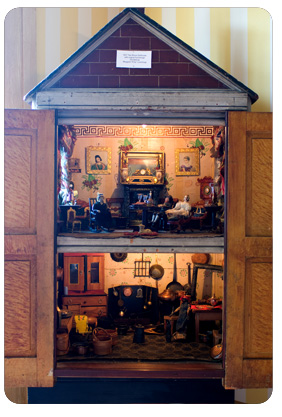
America
Wood and paint exterior
Eugene Field House
Descriptive Detail
In this upstairs parlor, two elegantly dressed women and a man sit in chairs near a small round table displaying an assortment of books and wine glasses. From pictures on the wall, to curtains at the windows, to the frilly white dress of the girl, there seems to be everything necessary for a leisurely afternoon or evening of reading, music, or visiting with family and friends. Downstairs the cast-iron stove, pots, pans, churns, and large tubs in this kitchen suggest that this is a place of work and activity. Who is the dark-skinned woman standing by a table? The two hinged doors of this 1837 miniature house are open, giving us a glimpse into everyday life in the nineteenth century.
Local Historical Connections
Elaborately and carefully decorated with great attention to detail, this two-story dollhouse reflects a way of life in which the family—as symbolized by the upstairs—is supported by others in the downstairs who provide many of the services that make the household run smoothly. Commonly called a “baby’s house” because of its small size, the decoration in this one replicates the home of the family to who owned it. Most likely custom-made with hinged doors that open and close, it is a construction style typical of the period. Although it did not belong to the Field family, it is an excellent example of one that might well have. It is reflective of the lifestyle and divisions of labor common to families such as the Fields who had servants, cooks, and a nanny to help run their home. Records indicate that the Fields did not have either free or enslaved blacks in their household, but did have the services of two young Mormon women.
National Historical Connections
Much more elaborate versions of miniature houses date back to sixteenth-century Europe. As examples of personal wealth and status, the first dollhouse on record belonged to Albrecht V, Duke of Bavaria. Not conceived of as a plaything for children, their popularity grew among the very wealthy who commissioned designers, architects, and craftspeople to build and furnish them. As these houses grew in popularity, their function also changed. At times they were used for instructional purposes to teach about household duties. By the nineteenth century, interest in miniature collecting and dollhouses grew substantially, resulting in dollhouses that reflected everyday life. By the twentieth century a wide assortment of styles and materials came on the market. Dollhouses became cherished items in homes, nursery schools, and community playrooms. Then as now, toys such as this dollhouse are in many respects teaching tools that introduce young children to the duties and expectations they will encounter in their adult lives.
top^
next artifact}
|

|



